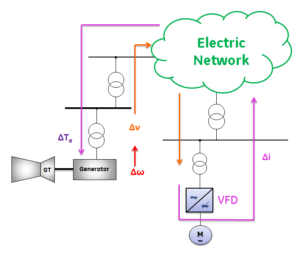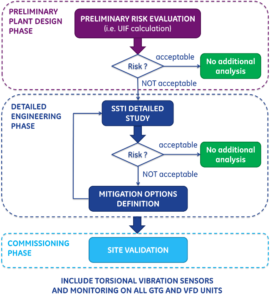Proper engineering can strengthen your plant design using large VFDs
“Variable Frequency Drives (VFDs) are widely used in the Oil & Gas industry to enable variable speed operation of motors. These drives use power electronic devices, which produce current and voltage harmonic distortion. They can also interact with other units connected to the same electrical grid (i.e. turbine-generators) via a phenomenon called Sub-Synchronous Torsional Interactions (SSTI)," say Paola Rotondo, Federico Svetti, Daniel Sgro, and Francesco Meucci, engineers of Baker Hughes, a GE Company, in the paper, "Practical guidelines for oil & gas plant design against sub-synchronous torsional interaction phenomena" at the 44th Turbomachinery Symposium.
The authors fully evaluate the SSTI phenomenon and give “practical guidelines to enable the following: a proper design of the plant and the system, an optimization of plant operability, and a strategy for mitigation of potential problems. Field test results and simulation analyses are presented, emphasizing the importance of a proper SSTI evaluation and management in the early engineering phase.”
“System integration is becoming more and more critical for complex Oil&Gas applications in particular considering increasing power rating of VFDs that are now reaching about 100 MW. These VFDs share the same grid as turbine-generator units and other devices.
There are many aspects that can influence the torsional response of generator units: grid events, torsional interaction with large power system unit controls, harmonics produced by power electronics devices, sub-synchronous resonances (i.e. typically with series capacitor-compensated lines), and load variations.
Experience indicates that large power-electronic systems can pose a risk of shaft-line torsional vibrations. As schematically shown in Figure 1, VFDs can electromechanically interact with torsional modes of turbine-generators connected to the same grid leading to torsional instability. This instability can produce network blackout and/or damage on rotating machines impacting Oil&Gas plant availability.
Basically, any turbine-generator unit tends to torsionally vibrate at its torsional natural frequencies (TNFs); normally the first torsional mode is the most involved one. Speed oscillations (Δω) of the shaft-line at that frequency (1st TNF) can cause voltage oscillations (Δv) in the grid through the electric generator itself. These voltage oscillations are seen as a disturbance by a VFD (or by any other power electronic load), which reacts injecting current oscillations (Δi) into the grid. Those current oscillations become electrical torque oscillations (ΔTe) through the generator electromagnetic field, establishing the SSTI phenomenon.

Figure 1: SSTI phenomenon schematization[/caption]
“Based on the authors’ site experiences, the main drivers of the SSTI phenomenon for Oil&Gas plants are:
- Grid configuration (i.e. island electrical grid operation)
- Available short circuit power levels evaluated at the connection bus of power electronic loads operating on the same grid Generator ratings and location in the grid
- Generator torsional natural frequencies and relevant mode shapes
- Rating, topology and control settings of power electronic loads (i.e. VFDs) connected to the electrical grid
After a theoretical overview and conceptual explanation, site experiences are presented showing how different plant configurations can impact the SSTI phenomenon. This emphasizes the actual applicability of the SSTI theory to real cases in the Oil&Gas industry.
Simulation analyses are carried out to demonstrate concepts and assumptions driving the SSTI studies. Test results are compared with simulations to highlight how an SSTI assessment and analysis performed in both the early and detailed engineering phases can help mitigate and manage potential SSTI risk at site.”

Figure 33: Summary of SSTI practical guidelines for Oil&Gas plants[/caption]
This paper matters because the authors use real site experiences to derive a theory that helps understand the SSTI phenomenon. Their “simulation results led to a comprehensive understating of the main drivers of this phenomenon leading the authors to provide a set of practical guidelines to properly manage SSTI risk since early plant definition phase. Figure 33 provides a schematic summary of the practical guidelines described in the paper.”